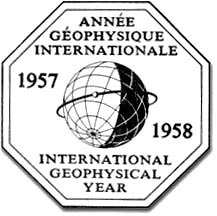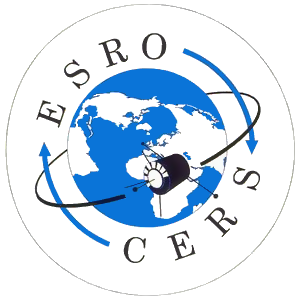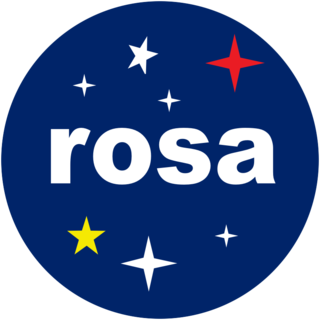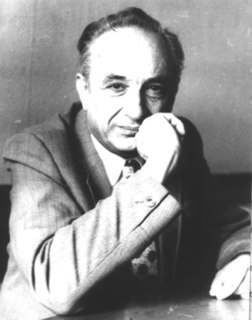Related Research Articles

The International Geophysical Year was an international scientific project that lasted from 1 July 1957 to 31 December 1958. It marked the end of a long period during the Cold War when scientific interchange between East and West had been seriously interrupted. Sixty-seven countries participated in IGY projects, although one notable exception was the mainland People's Republic of China, which was protesting against the participation of the Republic of China (Taiwan). East and West agreed to nominate the Belgian Marcel Nicolet as secretary general of the associated international organization.
Matra Marconi Space (MMS) was a Franco-British aerospace company.

James Alfred Van Allen was an American space scientist at the University of Iowa. He was instrumental in establishing the field of magnetospheric research in space.

A sounding rocket or rocketsonde, sometimes called a research rocket or a suborbital rocket, is an instrument-carrying rocket designed to take measurements and perform scientific experiments during its sub-orbital flight. The rockets are used to launch instruments from 48 to 145 km above the surface of the Earth, the altitude generally between weather balloons and satellites; the maximum altitude for balloons is about 40 km and the minimum for satellites is approximately 121 km. Certain sounding rockets have an apogee between 1,000 and 1,500 km, such as the Black Brant X and XII, which is the maximum apogee of their class. Sounding rockets often use military surplus rocket motors. NASA routinely flies the Terrier Mk 70 boosted Improved Orion, lifting 270–450-kg (600–1,000-pound) payloads into the exoatmospheric region between 97 and 201 km.

The Prospero satellite, also known as the X-3, was launched by the United Kingdom in 1971. It was designed to undertake a series of experiments to study the effects of space environment on communications satellites and remained operational until 1973, after which it was contacted annually for over 25 years. Although Prospero was the first British satellite to have been launched successfully by a British rocket, the first British satellite placed in orbit was Ariel 1, launched in April 1962 on a U.S. rocket.
Richard Anthony Harrison MBE FRAS FInstP is the Head of Space Physics Division and Chief Scientist at the Rutherford Appleton Laboratory in the United Kingdom. He is best known for his magnetic twisting theory involving the coronal heating problem of the Sun's atmosphere.
Desmond George King-Hele FRS was a British physicist, poet and author who crossed the divide between the arts and science to write extensively about the life of Erasmus Darwin, whom he linked with the romantic poets Shelley, Wordsworth, and Coleridge. In 1957, together with Doreen Gilmour, and as part of the Guided Weapons department of Royal Aircraft Establishment, he wrote a report proposing the use of the Blue Streak missile and Black Knight as a satellite launcher. See also Blue Streak Satellite Launch Vehicle.

Skylark was a family of British sounding rockets. The Skylark was first launched in 1957 from Woomera, Australia and its 441st and final launch took place from Esrange, Sweden on 2 May 2005. Launches had been carried out from sites in Europe, Australia, and South America, with use far beyond the UK by NASA, the European Space Research Organisation (ESRO), and German and Swedish space organizations.
The Committee on Space Research (COSPAR) was established in 1958 by the International Council for Scientific Unions (ICSU). Among COSPAR's objectives are the promotion of scientific research in space on an international level, with emphasis on the free exchange of results, information, and opinions, and providing a forum, open to all scientists, for the discussion of problems that may affect space research. These objectives are achieved through the organization of symposia, publication, and other means. COSPAR has created a number of research programmes on different topics, a few in cooperation with other scientific Unions. The long-term project COSPAR international reference atmosphere started in 1960; since then it has produced several editions of the high-atmosphere code CIRA. The code "IRI" of the URSI-COSPAR working group on the International Reference Ionosphere was first edited in 1978 and is yearly updated.

The European Space Research Organisation (ESRO) was an international organisation founded by 10 European nations with the intention of jointly pursuing scientific research in space. It was founded in 1964. As an organisation ESRO was based on a previously existing international scientific institution, CERN. The ESRO convention, the organisations founding document outlines it as an entity exclusively devoted to scientific pursuits. This was the case for most of its lifetime but in the final years before the formation of ESA, the European Space Agency, ESRO began a programme in the field of telecommunications. Consequently, ESA is not a mainly pure science focused entity but concentrates on telecommunications, earth observation and other application motivated activities. ESRO was merged with ELDO in 1975 to form the European Space Agency.
Sir Robert Wilson was the son of a Durham miner. He studied physics at King's College, Durham and obtained his PhD in Edinburgh, where he worked at the Royal Observatory on stellar spectra. He was an astronomer, who fully embraced the opportunities provided by the space age and he was one of the pioneers who laid the groundwork for the development of the Great Space Observatories, such as the Hubble Space Telescope.

Sir Harrie Stewart Wilson Massey was an Australian mathematical physicist who worked primarily in the fields of atomic and atmospheric physics.
The International Designator, also known as COSPAR ID, is an international identifier assigned to artificial objects in space. It consists of the launch year, a three-digit incrementing launch number of that year and up to a three-letter code representing the sequential identifier of a piece in a launch. In TLE format the first two digits of the year and the dash are dropped.

The Romanian Space Agency is a public institution with extrabudgetary funding which coordinates the national space technology research programs and the space research related activities since 1991. ROSA is subordinated to the Ministry of Education.
Ariel was a British satellite research programme conducted between the early 1960s and 1980s. Six satellites were launched as part of the programme, starting with the first British satellite, Ariel 1, which was launched on 26 April 1962, and concluding with the launch of Ariel 6 on 2 June 1979. The launch of Ariel 1 made Britain the third country to have a satellite orbiting the Earth. The first four were devoted to studying the ionosphere, the remaining two to X-ray astronomy and cosmic-ray studies.

Ariel 1, was the first British satellite, and the first satellite in the Ariel programme. Its launch in 1962 made the United Kingdom the third country to operate a satellite, after the Soviet Union and the United States. It was constructed in both the UK and the United States by NASA Goddard Space Flight Center and SERC, under an agreement reached as the result of political discussions in 1959 and 1960. The US Starfish Prime high-altitude nuclear test affected Ariel 1's operational capability.

Space research is scientific study carried out in outer space, and by studying outer space. From the use of space technology to the observable universe, space research is a wide research field. Earth science, materials science, biology, medicine, and physics all apply to the space research environment. The term includes scientific payloads at any altitude from deep space to low Earth orbit, extended to include sounding rocket research in the upper atmosphere, and high-altitude balloons.
The COSPAR International Reference Atmosphere (CIRA) is an empirical model of the atmosphere of Earth. It consists of a set of tables of average air pressures, altitudes and temperatures. The CIRA models are developed by the Committee on Space Research (COSPAR) and have been important for the planning of spaceflight.
Henry Elliot, was a British space scientist, and Emeritus Professor of Physics, at the University of London.

Rolan I. Kiladze (1931–2010) was a Georgian astronomer, a Doctor of Physical and Mathematical Sciences (1982), and a Corresponding Member of the National Academy of Sciences of Georgia (1988).
References
- Godwin, Matthew (2007). The Skylark Rocket: British Space Science and the European Space Research Organisation, 1957–1972. Editions Beauchesne. ISBN 9782701015118.
- Massie, Harrie; Robins, M. O. (1986). History of British Space Science. Cambridge University Press. pp. 106–108. doi:10.1017/CBO9780511898075. ISBN 9780511898075.
- King-Hele, D. (2005). A Tapestry of Orbits. Cambridge University Press. ISBN 9780521017329.
- Millard, Douglas (April 2005). "An Overview of United Kingdom Space Activity 1957–1987" (PDF). Esa History Study Reports. The Netherlands: ESA. ISSN 1683-4704. HSR-36.
- Pounds, Ken (14 July 2010). "The Royal Society's formative role in UK space research". Notes and Records of the Royal Society. 64: S65–S76. doi:10.1098/rsnr.2010.0039. ISSN 1743-0178. S2CID 144418241.